Friction-Induced Vibration of a Railway Wheelset-Track System and Its Effect on Rail Corrugation
Abstract
:1. Introduction
1.1. Background
1.2. Formulation of the Interest Problem
1.3. Literature Survey
1.4. Scope and Contribution of This Study
1.5. Organization of the Paper
2. Slip of a Wheel on a Rail
2.1. Slip of a Wheel on a Rail
2.2. Correlation between Rail Corrugation and Slip of the Wheel on the Rail
3. Squealing Vibration of a Wheelset-Track System
3.1. Model of the Squealing Vibration of a Wheelset-Track System
- (1)
- Step 1: nonlinear static analysis for applying axle-box forces.
- (2)
- Step 2: nonlinear static analysis to impose the transversal sliding speed on the wheelset.
- (3)
- Step 3: normal mode analysis to extract natural frequencies of the undamped system.
- (4)
- Step 4: complex eigenvalue analysis that incorporates the effect of friction coupling.
3.2. Prediction Result of Squealing Vibration of the Wheelset-Track System
3.3. Field Measurement of the Squealing Vibration of the Wheelset-Track System
3.4. Correlation between the Rail Corrugation and the Squealing Vibration of the Wheelset-Track System
4. Simple Validation of the Prediction Model of Rail Corrugation
5. Conclusions
- (1)
- In a tightly curved track, the slip of the wheel of the leading wheelset on the rail always occurs.
- (2)
- When the creep force between the wheel and rail is saturated, the wheelset-track system has a strong occurrence propensity of unstable vibrations.
- (3)
- The unstable vibration of the wheelset-track system is probably a wavelength-fixing mechanism.
- (4)
- The accuracy of the rail corrugation prediction based on the unstable vibrations of wheelset-track systems is found to be 85–90% or higher.
Funding
Conflicts of Interest
Appendix A
References
- Grassie, S.L. Rail Corrugation, Chapter 11, Wheel/Rail Interface Handbook; Lewis, R., Olofsson, U., Eds.; CRC Press: Boca Raton, FL, USA, 2009; pp. 349–376. [Google Scholar]
- Oostermeijer, K.H. Review on short pitch rail corrugation studies. Wear 2008, 265, 1231–1237. [Google Scholar] [CrossRef]
- Sato, Y.; Matsumoto, A.; Knothe, K. Review on rail corrugation studies. Wear 2002, 253, 130–139. [Google Scholar] [CrossRef]
- Kinkaid, N.M.; O’Reilly, M.O.; Papadopoulos, P. Automotive disc brake squeal. J. Sound Vib. 2003, 267, 105–166. [Google Scholar] [CrossRef]
- Ibrahim, R.A. Friction-induced vibration, chatter, squeal, and chaos. Part 2. Dynamics and modeling. Appl. Mech. Rev. 1994, 47, 227–253. [Google Scholar] [CrossRef]
- Guida, D.; Nilvetti, F.; Pappalardo, C.M. Instability induced by dry friction. Int. J. Mech. 2009, 3, 44–51. [Google Scholar]
- Glocker, C.; Cataldi-Spinola, E.; Leine, R.I. Curve squealing of trains: Measurement, modelling and simulation. J. Sound Vib. 2009, 324, 365–386. [Google Scholar] [CrossRef]
- Ding, B.; Squicciarini, G.; Thompson, D. Effect of rail dynamics on curve squeal under constant friction conditions. J. Sound Vib. 2019, 442, 183–199. [Google Scholar] [CrossRef]
- Kalousek, J.; Johnson, K. An investigation of short pitch wheel and rail corrugations on the Vancouver mass transit system. Proc. Inst. Mech. Eng. Part F J. Rail Rapid Transit 1992, 206, 127–135. [Google Scholar] [CrossRef]
- Hempelmann, K.; Knothe, K. An extended linear model for the prediction of short pitch corrugation. Wear 1996, 191, 161–169. [Google Scholar] [CrossRef]
- Nielsen, J.C.O.; Lund, N.R.; Johansson, A.; Vernersson, T. Train-Track Interaction and Mechanisms of Irregular Wear on Wheel and Rail Surfaces. Veh. Syst. Dyn. 2003, 40, 43–54. [Google Scholar] [CrossRef]
- Gomez, J.; Vadillo, E.G.; Santamaria, J. A comprehensive track model for the improvement of corrugation models. J. Sound Vib. 2006, 293, 522–534. [Google Scholar] [CrossRef]
- Meehan, P.A.; Daniel, W.J.T.; Campey, T. Prediction of the growth of wear-type rail corrugation. Wear 2005, 258, 1001–1013. [Google Scholar] [CrossRef]
- Wu, T.X.; Thompson, D.J. An investigation into rail corrugation due to micro-slip under multiple wheel/rail interactions. Wear 2005, 258, 1115–1125. [Google Scholar] [CrossRef] [Green Version]
- Jin, X.S.; Wen, Z.F.; Wang, K.Y.; Zhou, Z.R.; Liu, Q.Y.; Li, C.H. Three-dimensional train-track model for study of rail corrugation. J. Sound Vib. 2006, 293, 830–855. [Google Scholar] [CrossRef]
- Valdivia, A.R. A linear dynamic wear model to explain the initiating mechanism of corrugation. Veh. Syst. Dyn. 1988, 17, 493–496. [Google Scholar] [CrossRef]
- Tassilly, E.; Vincent, N. A linear model for the corrugation of rails. J. Sound Vib. 1991, 150, 25–45. [Google Scholar] [CrossRef]
- Muller, S. A linear wheel-rail model to investigate stability and corrugation on straight track. Wear 2000, 243, 122–132. [Google Scholar] [CrossRef]
- Igeland, A.; Ilias, H. Rail head corrugation growth predictions based on non-linear high frequency vehicle/track interaction. Wear 1997, 213, 90–97. [Google Scholar] [CrossRef]
- Torstensson, P.T.; Nielsen, J.C.O. Simulation of dynamic vehicle-track interaction on small radius curves Veh. Syst. Dyn. 2011, 49, 1711–1732. [Google Scholar] [CrossRef]
- Sheng, X.; Thompson, D.J.; Jones, C.J.C.; Xie, G. Simulations of roughness initiation and growth on railway rails. J. Sound Vib. 2006, 293, 819–829. [Google Scholar] [CrossRef]
- Torstensson, P.T.; Schilke, M. Rail corrugation growth on small radius curves-Measurements and validation of a numerical prediction model. Wear 2013, 303, 381–396. [Google Scholar] [CrossRef]
- Hiensch, M.; Nielsen, J.C.O.; Verheijen, E. Rail corrugation in The Netherlands-measurements and simulations. Wear 2002, 253, 140–149. [Google Scholar] [CrossRef]
- Tassilly, E.; Vincent, N. Rail corrugations: Analytical model and field tests. Wear 1991, 144, 163–178. [Google Scholar] [CrossRef]
- Diana, G.; Cheli, F.; Bruni, S.; Collina, A. Experimental and numerical investigation on subway short pitch corrugation. Veh. Syst. Dyn. 1998, 29, 234–245. [Google Scholar] [CrossRef]
- Batten, R.D.; Bellette, P.A.; Meehan, P.A.; Horwood, R.J.; Daniel, W.J.T. Field and theoretical investigation of the mechanism of corrugation wavelength fixation under speed variation. Wear 2011, 271, 278–286. [Google Scholar] [CrossRef]
- Vila, P.; Fayos, J.; Baeza, L. Simulation of the evolution of rail corrugation using a rotating flexible wheelset model. Veh. Syst. Dyn. 2011, 49, 1749–1769. [Google Scholar] [CrossRef]
- Baeza, L.; Vila, P.; Xie, G.; Iwnicki, S.D. Prediction of rail corrugation using a rotating flexible wheelset coupled with a flexible track model and a non-Hertzian/non-steady contact model. J. Sound Vib. 2011, 330, 4493–4507. [Google Scholar] [CrossRef]
- Liu, S.Q. Study on rail corrugation on metro tracks and its suppression. Railw. Signal. Commun. 2014, 5, 18–19. [Google Scholar]
- Brockley, C.A.; Ko, P.L. An investigation of rail corrugation using friction-induced vibration theory. Wear 1988, 128, 99–105. [Google Scholar] [CrossRef]
- Suda, Y.; Hanawa, M.; Okumura, M.; Iwasa, T. Study on rail corrugation in sharp curves of commuter line. Wear 2002, 253, 193–198. [Google Scholar] [CrossRef]
- Sun, Y.Q.; Simson, S. Wagon-track modelling and parametric study on rail corrugation initiation due to wheel stick-slip process on curved track. Wear 2008, 265, 1193–1201. [Google Scholar] [CrossRef]
- Saulot, A.; Baillet, L. Dynamic finite element simulations for understanding wheel-rail contact oscillatory states occurring under sliding conditions. J. Tribol. 2006, 128, 761–770. [Google Scholar] [CrossRef]
- Chen, G.X.; Zhou, Z.R.; Ouyang, H.; Jin, X.S.; Zhu, M.H.; Liu, Q.Y. A finite element study on rail corrugation based on saturated creep force-induced self-excited vibration of a wheelset–track System. J. Sound Vib. 2010, 329, 4643–4655. [Google Scholar] [CrossRef]
- Cui, X.L.; Chen, G.X.; Zhao, J.W.; Yan, W.Y.; Ouyang, H.; Zhu, M.H. Field investigation and numerical study of the rail corrugation caused by frictional self-excited vibration. Wear 2017, 376–377, 1919–1929. [Google Scholar] [CrossRef]
- Cui, X.L.; Chen, G.X.; Yang, H.G.; Zhang, Q.; Ouyang, H.; Zhu, M.H. Effect of the wheel/rail contact angle and the direction of the saturated creep force on rail corrugation. Wear 2015, 330, 554–562. [Google Scholar] [CrossRef]
- Shabana, A.A.; Zaazaa, K.E.; Sugiyama, H. Railroad Vehicle Dynamics: A Computational Approach; CRC Press: Boca Raton, FL, USA, 2007. [Google Scholar]
- Pombo, J.; Ambrósio, J.; Silva, M. A new wheel–rail contact model for railway dynamics. Veh. Syst. Dyn. 2007, 45, 165–189. [Google Scholar] [CrossRef]
- Pombo, J.C.; Ambrósio, J.A. Application of a wheel–rail contact model to railway dynamics in small radius curved tracks. Multibody Syst. Dyn. 2008, 19, 91–114. [Google Scholar] [CrossRef]
- Chen, G.X.; Zhou, Z.R.; Kapsa, P.; Vincent, L. Experimental investigation into squeal under reciprocating sliding. Tribol. Int. 2003, 36, 961–971. [Google Scholar] [CrossRef]
- Chen, G.X.; Zhang, S.; Wu, B.W.; Zhao, X.N.; Wen, Z.F.; Ouyang, H.; Zhu, M.H. A comparative study between The field measurement and prediction of rail corrugation. In Proceedings of the 11th International Conference on Contact Mechanics and Wear of Rail/Wheel Systems, Delft, The Netherlands, 24–27 September 2018. [Google Scholar]

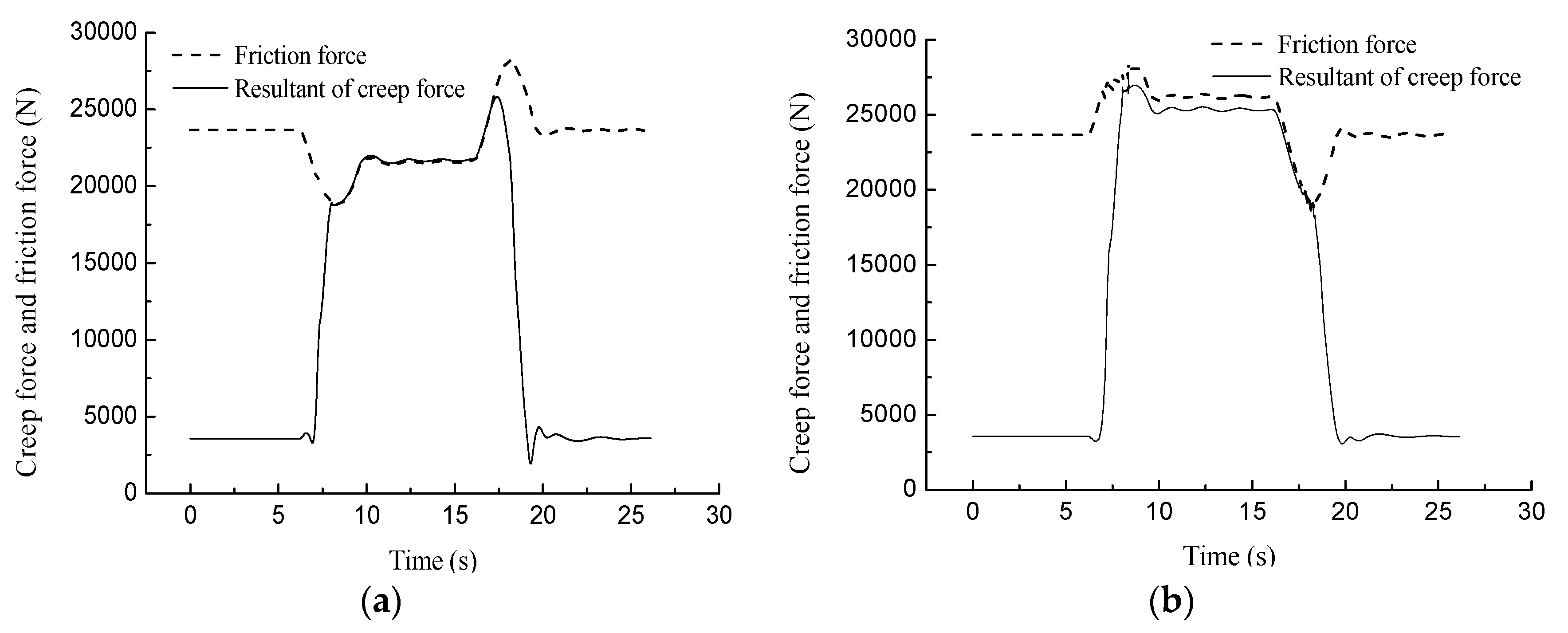
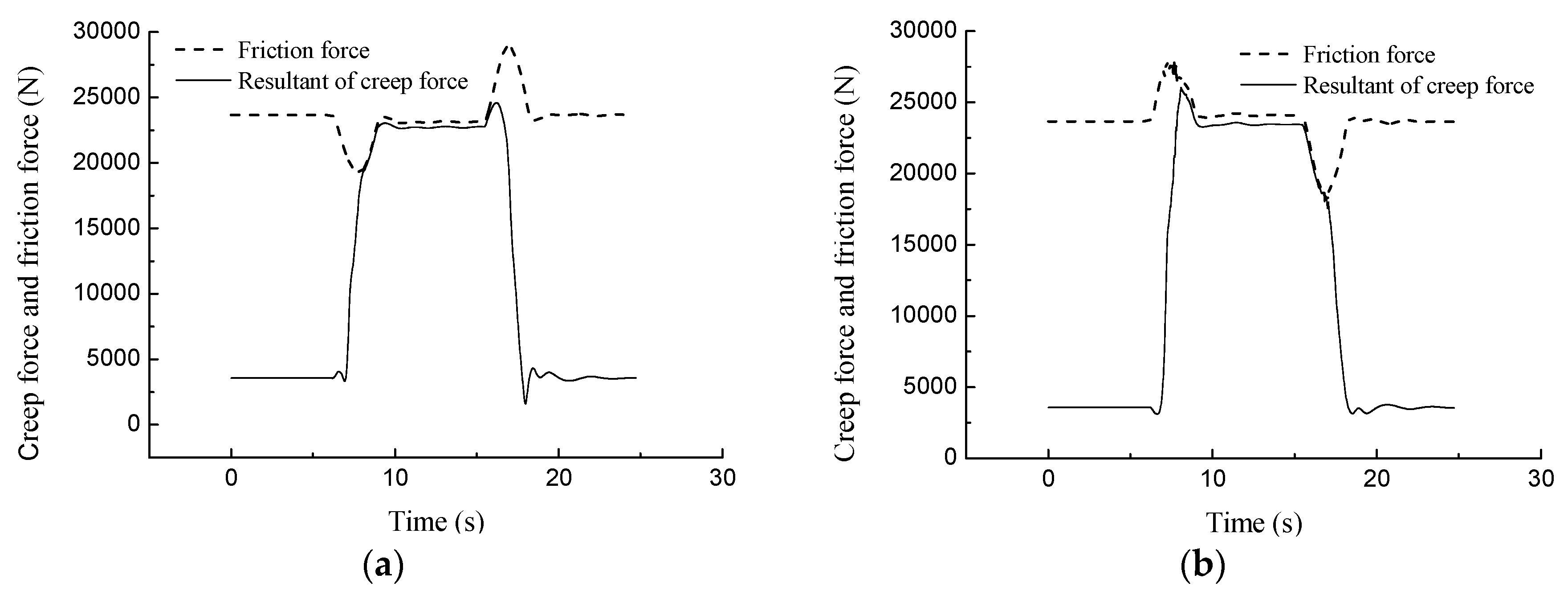

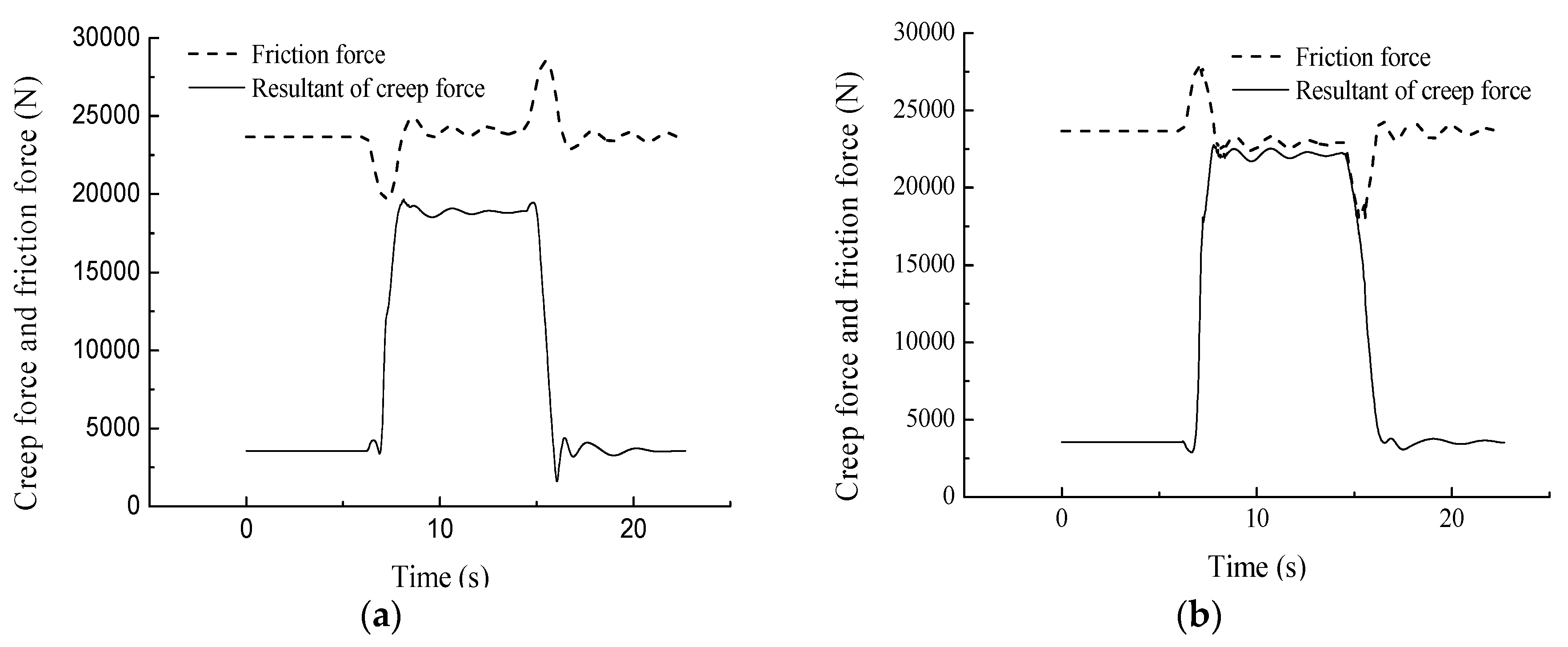
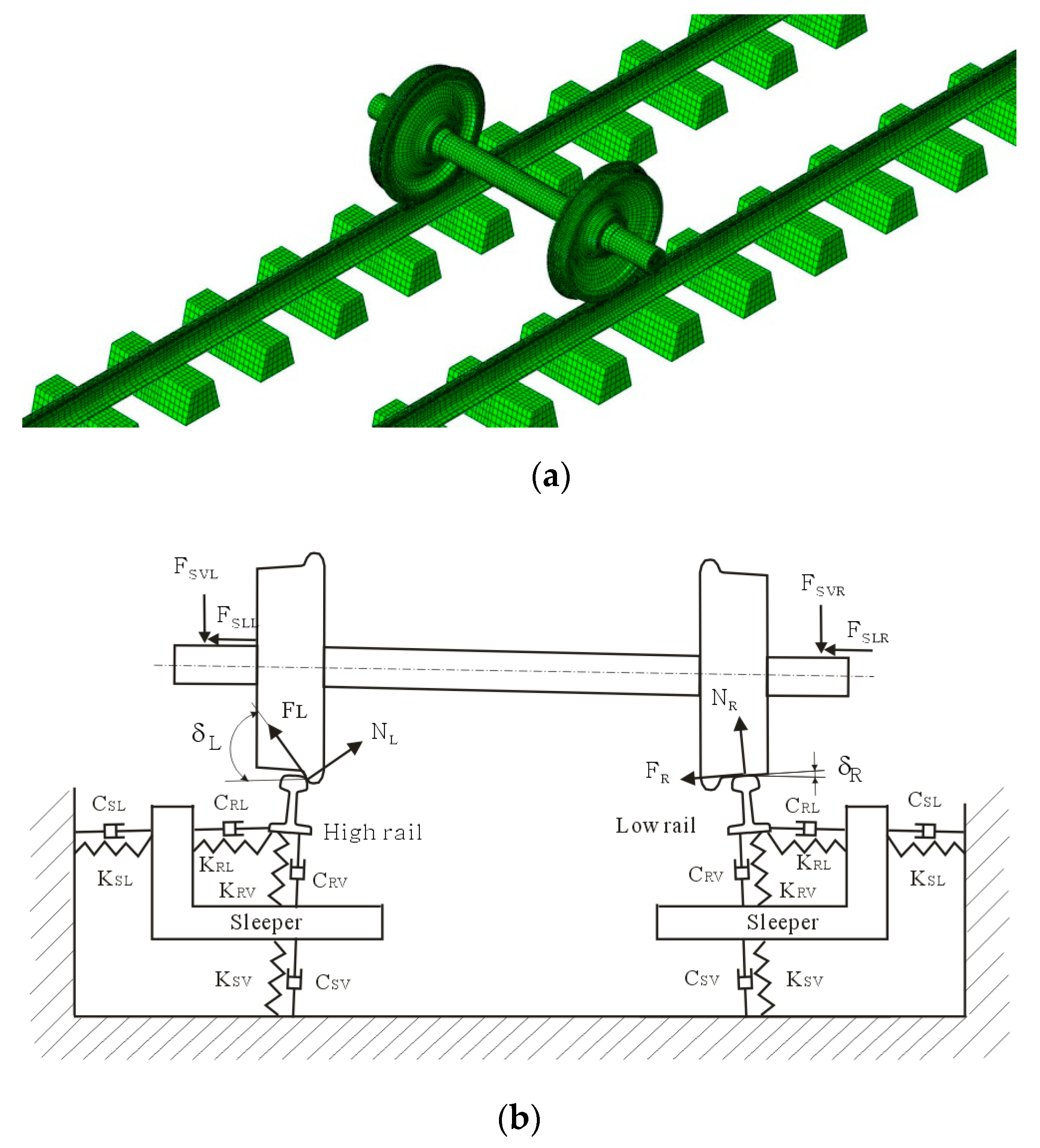

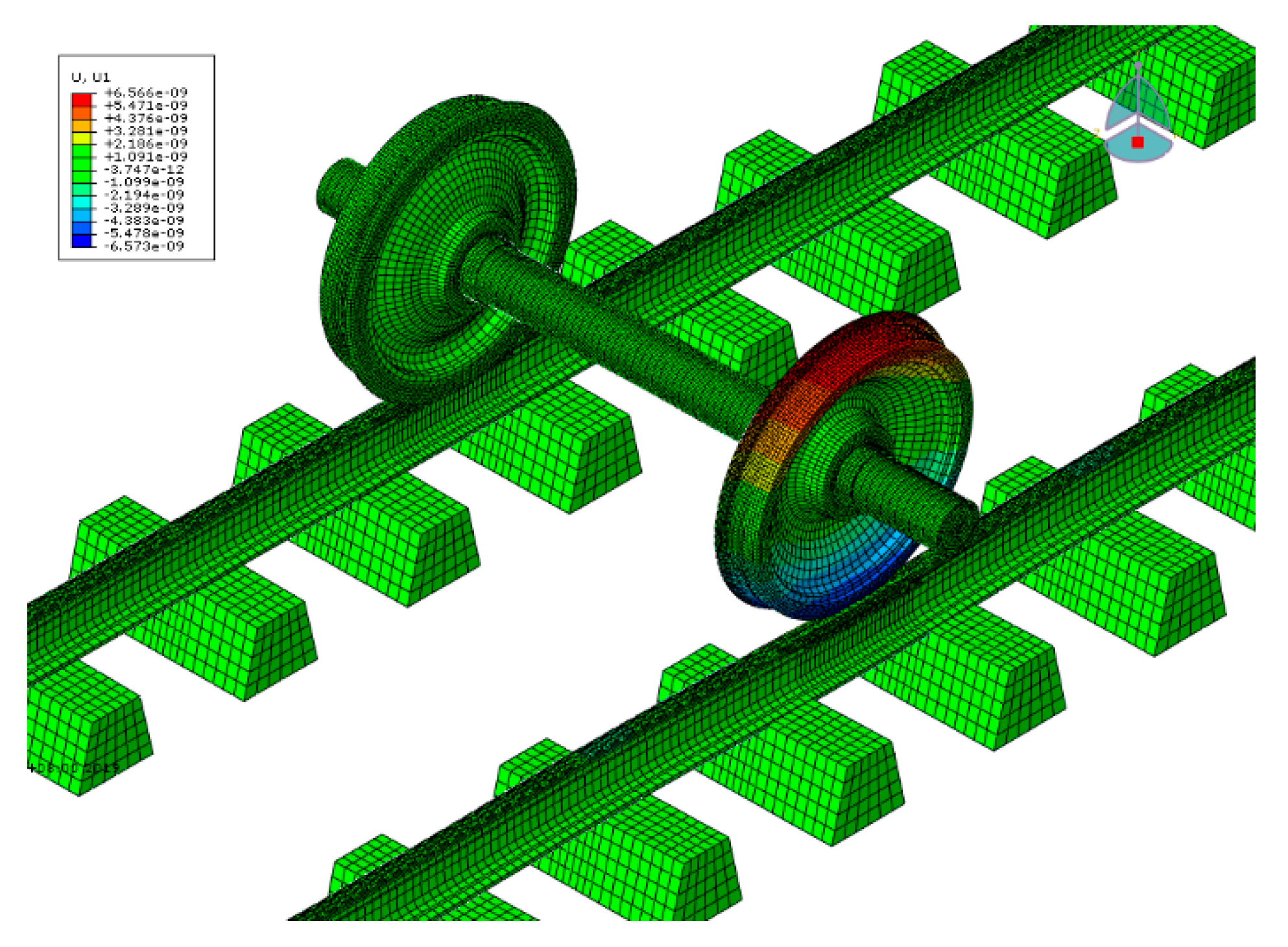
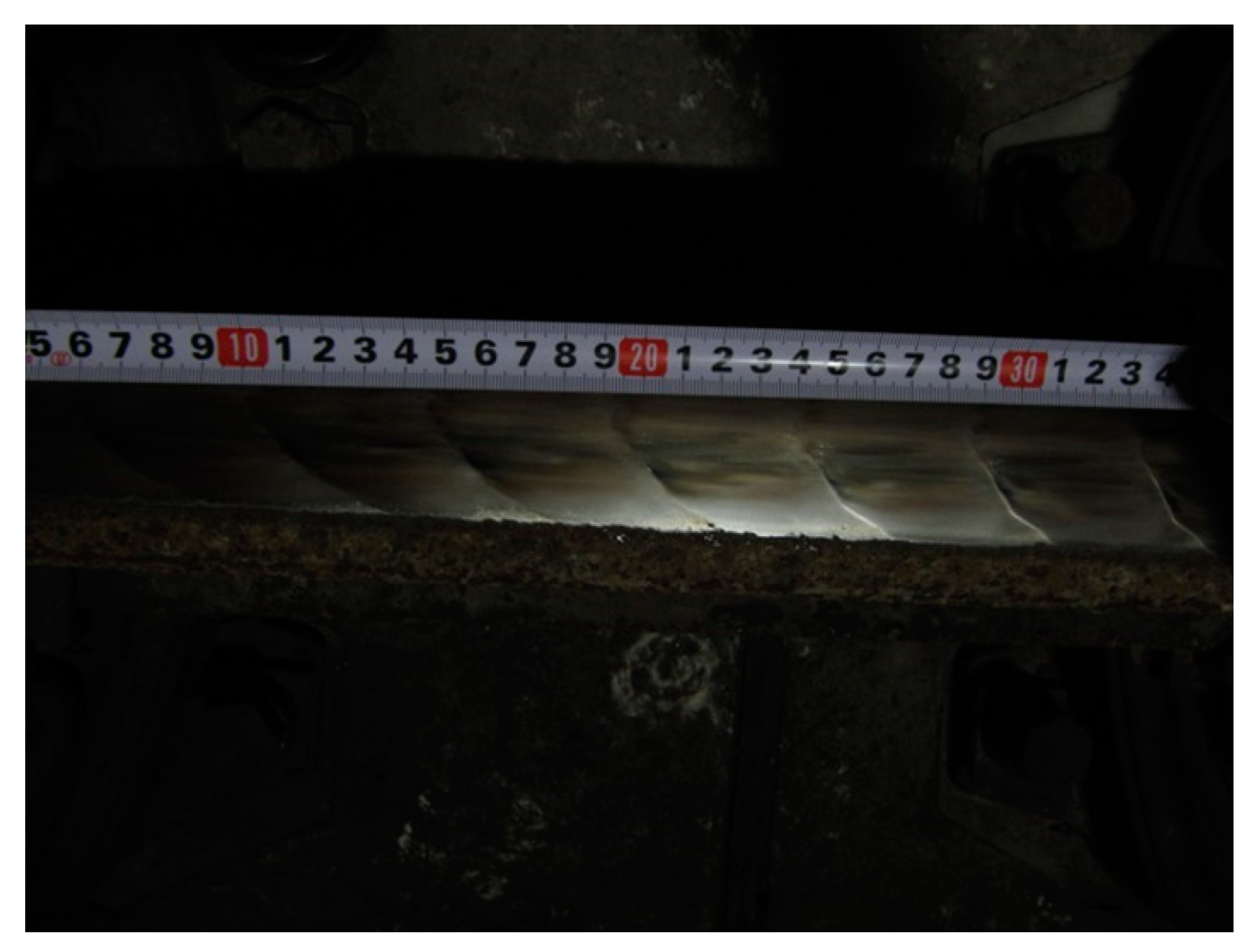
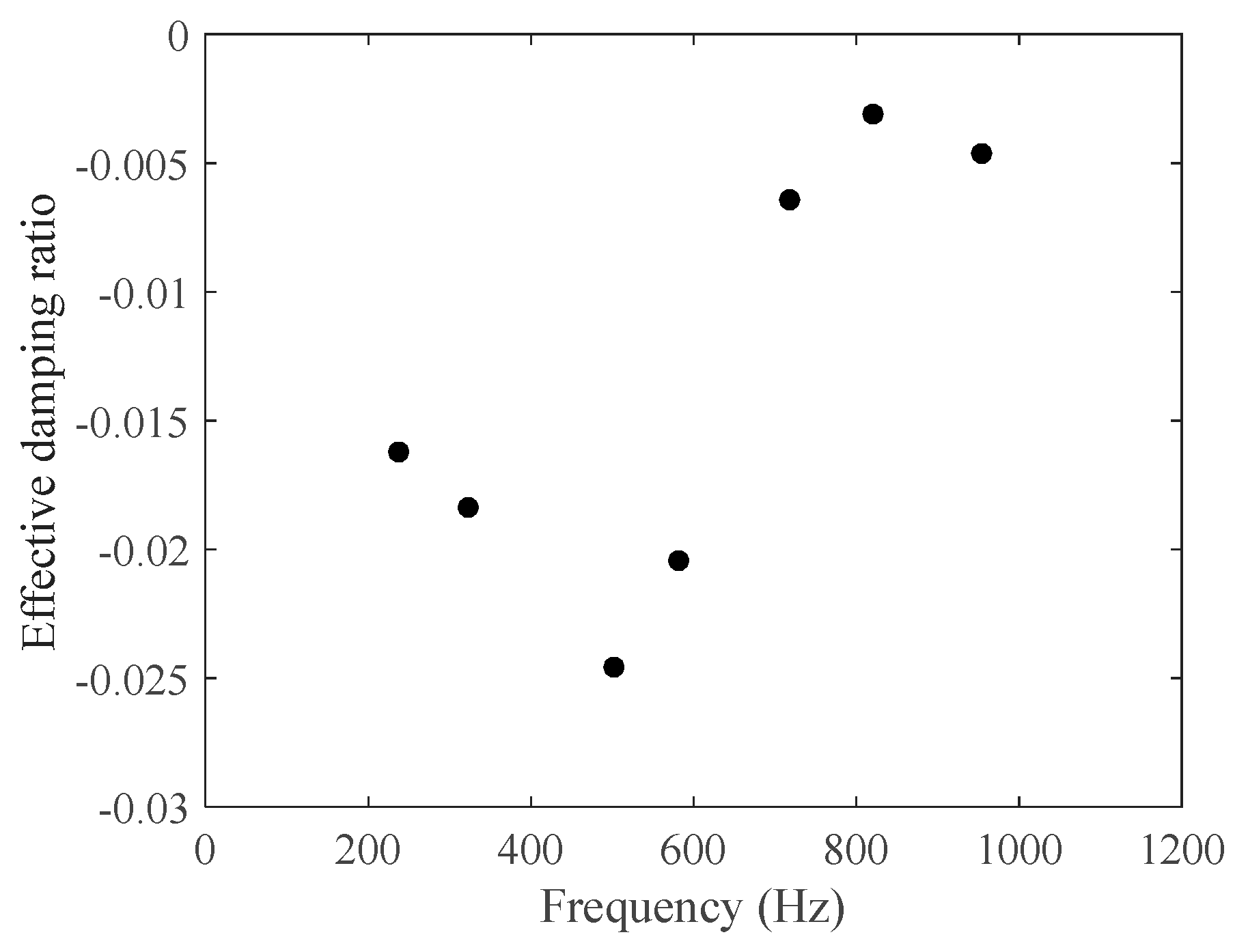
| Track | |
|---|---|
| Density of rail (kg/m3) | 7800 |
| Young’s modulus of rail (N/m2) | 2.1 × 1011 |
| Poisson’s ratio of rail | 0.3 |
| Length of rail (m) | 36 |
| Type of rail (kg/m) | 60 |
| Sleeper spacing (m) | 0.625 |
| Rail cant | 1/40 |
| Density of railpad (kg/m3) | 1300 |
| Young’s modulus of railpad (N/m2) | 8.0 × 107 |
| Poisson’s ratio | 0.45 |
| Thickness of railpad (m) | 0.012 |
| Density of sleeper (kg/m3) | 2480 |
| Young’s modulus of sleeper (N/m2) | 1.9 × 1011 |
| Poisson’s ratio of sleeper | 0.3 |
| Vertical support stiffness from | |
| monolithic track-bed (N/m) | 8.9 × 107 |
| Vertical support damping from | |
| monolithic track-bed (Ns/m) | 8.98 × 104 |
| Lateral support stiffness from | |
| monolithic track-bed (N/m) | 5.0 × 107 |
| Lateral support damping from | |
| monolithic track-bed (Ns/m) | 4.0 × 104 |
| Vehicle | |
| Gauge (mm) | 1435 |
| Wheelbase of bogie (mm) | 2300 |
| Profile of tread | LM-type worn profile |
| Mass of wheelset (kg) | 1365 |
| Moment of inertia of wheelset in | |
| vertical and lateral axes (kg m2) | 880 |
| Moment of inertia of wheelset in | |
| rolling axis (kg m2) | 116 |
| Mass of bogie (kg) | 2028 |
| Moment of inertia of bogie in | |
| longitudinal level axes (kg m2) | 983 |
| Moment of inertia of bogie in | |
| lateral level axes (kg m2) | 582 |
| Moment of inertia of bogie in | |
| vertical axes (kg m2) | 1506 |
| Mass of car body (kg) | 35,030 |
| Moment of inertia of car body in | |
| longitudinal level axes (kg m2) | 50,370 |
| Moment of inertia of car body in | |
| the lateral level axes (kg m2) | 1,395,430 |
| Moment of inertia of car body in | |
| vertical axes (kg m2) | 1,386,060 |
| Longitudinal stiffness of | |
| primary suspension alone (kN/m) | 4850 |
| Lateral stiffness of | |
| primary suspension alone (kN/m) | 3430 |
| Vertical stiffness of | |
| primary suspension alone (kN/m) | 740 |
| Vertical damping of | |
| primary suspension alone (kNs/m) | 15.626 |
| Vertical stiffness of | |
| secondary suspension alone (kN/m) | 480 |
| Lateral stiffness of | |
| secondary suspension alone (kN/m) | 210 |
| Vertical damping of | |
| secondary suspension alone (kNs/m) | 50 |
© 2020 by the author. Licensee MDPI, Basel, Switzerland. This article is an open access article distributed under the terms and conditions of the Creative Commons Attribution (CC BY) license (http://creativecommons.org/licenses/by/4.0/).
Share and Cite
Chen, G. Friction-Induced Vibration of a Railway Wheelset-Track System and Its Effect on Rail Corrugation. Lubricants 2020, 8, 18. https://doi.org/10.3390/lubricants8020018
Chen G. Friction-Induced Vibration of a Railway Wheelset-Track System and Its Effect on Rail Corrugation. Lubricants. 2020; 8(2):18. https://doi.org/10.3390/lubricants8020018
Chicago/Turabian StyleChen, Guangxiong. 2020. "Friction-Induced Vibration of a Railway Wheelset-Track System and Its Effect on Rail Corrugation" Lubricants 8, no. 2: 18. https://doi.org/10.3390/lubricants8020018
APA StyleChen, G. (2020). Friction-Induced Vibration of a Railway Wheelset-Track System and Its Effect on Rail Corrugation. Lubricants, 8(2), 18. https://doi.org/10.3390/lubricants8020018






